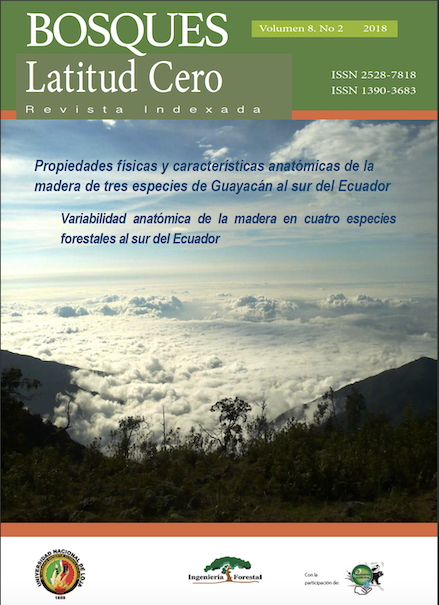Physical properties and wood anatomical characteristics of three species of Guayacán in southern Ecuador
Keywords:
Guayacán, Handroanthus chrysanthus, billbergii, serratifolius, physical properties, wood anatomyAbstract
The study was realized in the dry forest of southern Ecuador, in the Mangahurco, Nueva Fatima and Santa Lucia sectors. Three species were studied: Handroanthus chrysanthus, Handroanthus billbergii, and Handroanthus serratifolius. Wooden test tubes were obtained from the shaft of individual trees considering biogeographic characteristics of the site, and dasometric parameters. In each test tube the organoleptic, macroscopic and microscopic characteristics of the wood were deter-mined. The results showed an abrupt transition between the color of the heartwood (brown) and the sapwood (yellowish brown) of the three species. There were notable differences in the characteristics of the wood, H. chrysanthus of the Nueva Fátima sector presented the highest value of moisture content (18,54 %) and did not present contractions of its wood, while H. serratifolius presented the highest density basic. Respect to the anatomical characteristics, most species showed axial parenchyma of paratracheal type, confluent, unilateral paratracheal and in thin bands, as well as reticulated and escali-form, and simple perforation plates with polygonal alternating intervessel pits. H. billbergii, presented fibers with very thick cell walls, and H. chrysanthus from Nueva Fátima showed spindle-like cells of eight cells per strand of parenchyma. A notable difference was observed in the radios, where H. chry-santhus and H. serratifolius presented radios from 1 to 3 series, and H. billbergii was the only one that showed exclusively uniseriate radios, a key element for the differentiation of forest species through a wood sample. Therefore, this study provides the basis for the identification of forest species through their microscopic and anatomical characteristics of wood, especially those of high commercial value in southern Ecuador.References
Aguirre- Mendoza Z., Loja A., Solano M, y Aguirre N. (2015). Especies Forestales más aprovechadas del Sur de Ecuador. Universidad Nacional de Loja. Ecuador. 128p.
Aguirre, Zhofre. (2015). Pasado, presente y futuro de los “guayacanes” Handroanthus chrysanthus (Jacq.) S. O. Grose y Handroanthus billbergii (Bureau y K. Schum.) S. O. Grose, de los bosques secos de Loja, Ecuador. Arnaldoa. 22(1): 85-104.
Barghoorn, W., Cabrera, D. y Alvarado, P. (1967). Estudio orientativo de algunas propiedades anatómicas y físico -mecánicas de 41 especies maderables de la región Carare – Opón. Instituto de Investigaciones y Proyectos Forestales y Madereros de La Universidad Distrital. Bogotá, Colombia.
Corothie, H. (1948). Maderas de Venezuela. Ministerio de Agricultura y cría. Universidad de Michigan.
Chavesta, M. (2005). Maderas para pisos. Facultad de Ciencias Forestales, Universidad Nacional Agraria La Molina. Perú.
Chavesta, M. (2006). Separata de capacitación sobre identificación de madera. Perú. 8-13.
De Muñiz, G. I. B., y Marchiori, J. N. C. (2009). Anatomía da madeira de duas Bignoniáceas da Floresta Estacional de Misiones– Argentina. Balduinia, (18): 20- 25.
E. (Eds.). (1989). IAWA list of microscopic features for hardwood identification. Repr. IAWA Journal 10: 219-332.
Kribs, D. 1950. Comercial Foreign Word on the American Market. Dower Publication. Inc the Pensylvania State University. New Cork, United States.
González, A. (2013). Indumento, nectarios extraflorales y anatomía foliar en Bignoniaceas de la Argentina.
Grande, D., Polanco, C. (2007). Descripción anatómica de la madera de cuarenta especies del bosque Alto-Andino en GUASCA, Cundinamarca. Colombia Forestal. 10 (20): 180-206
Grose, S y Olmsted R. (2007). Taxonomic revisions in the polyphyletic genus Tabebuia s.1. (Bignoniaceae). Department of Biology, University of Washington. Systematic Botany, 32 (3): 660-670.
Ibáñez, C. (2001). La Madera: Composición, alteraciones y restauración. Recuperado de: https://grupos.unican.es/acanto/ aep/bolpas/la_madera_BMVP- 2001.htm
Leonardi, D., Sapio, O., Gattuso, M. y Gattuso S. (2002). Caracteres morfoanatómicos de la corteza y hojas de Tabebuia impetiginosa y T. heptaphylla (Bignoniaceae). Sociedad Argentina de Botánica. 37 (1-2): 51-61
León, W. (2007). Anatomía del Xilema Secundario de 10 especies de la familia Bignoniaceae de Venezuela. Universidad de los Andes. Mérida, Venezuela.
León, W. (2009). Anatomía de la Madera y Clave de Identificación para Especies Forestales Vedadas en Venezuela. Revista Forestal Venezolana, 51-62.
León, W. (2014). Anatomía de maderas de 108 especies de Venezuela. Universidad de los Andes, Revista Pittierria.
Marchiori, J. N. C. (2009). Estudo anatômico da madeira de Handroanthus pulcherrimus (Sandwith) S. Grose. Balduinia, (19): 10-13.
Morris, C. y Rey, J. (1974). Clave macro y micrográfica de catorce (14) maderas colombianas. Tesis de grado. Ingeniería forestal. Universidad Distrital Francisco José de Caldas. Santafé de Bogotá.
Nutsch, W. (1999). Tecnología de la madera y mueble. Editorial Reverté, S.A.
Parolin, P. (2002). Radial gradients in wood specific gravity in trees of Central Amazonian Floodplains. IAWA Journal. (23): 449-457.
Pérez, A. (1987). La identificación anatómica de maderas en Latinoamérica. Acta Botánica Brasilica. (2): 291-297.
Pineda, S., León, W., y Valero, S. (2016). Madera de frondosas: cedro, apamate, curarire y divi, utilizadas en armaduras de cubiertas y carpintería de las viviendas de mampostería del casco histórico de Maracaibo, Ve-nezuela. Revista electrónica ReCoPar, (11): 18-38.
Rodríguez, R., Palacios, H y Lomelí M. (2007). Estructura anatómica de la madera. Ciencia y Desarrollo. 33 (213): 24-29.
SENA. (2012). Guayacán, Polvillo (Tabebuia serratifolia). Disponible en: http://www.cmm.com.co/assets/pdf/Guayacan_Polvillo_(Tabebuia_serratifolia).pdf
Silva, J. (2009). Determinación de las características anatómicas y propiedades físicas de la madera de la especie forestal madero negro o guayacán (Tabebuia billbergii) de la región Tumbes. Tesis Ingeniero Fores-tal, Facultad de Ciencias Agrarias. Escuela de Ingeniería Forestal y Medio Ambiente, Universidad Nacional de Tumbes. Perú. 130p.
Villalba, H. (2010). Materiales de uso técnico. La Madera. Disponible en: https://iesvillalbahervastecnologi a.files.wordpress.com/2010/02/ materiales_madera.pdf
Vinueza, M. (2012). Fichas técnicas de especies forestales. Ficha técnica Nº 6: Guayacán. Ecuador Forestal. Disponible en: https://ecuadorforestal.org/fichas-tecnicas-de-especies-forestales/ficha-tecnica-no-6-guayacan/
Zapater, M. y Lozano, E. (2009). Delimitación y estatus de Handroanthus heptaphyllus y H. impetiginosus (Tecomae, Bignoniaceae). Darwiniana. 46 (2): 304-317
Zapater, M., Califano, L., Castillo, E., Quiroga, M. y Lozano, E. (2009). Las Especies Nativas Y Exóticas De Tabebuia Y Handroanthus (Tecomae, Bignoniaceae) En Argentina. Darwiniana. 47 (1): 185 -220.
Downloads
Published
How to Cite
Issue
Section
License
Copyright (c) 2018 Bosques Latitud Cero

This work is licensed under a Creative Commons Attribution-NonCommercial-ShareAlike 4.0 International License.
This work is published under the Creative Commons Attribution-NonCommercial-ShareAlike 4.0 International (CC BY-NC-SA 4.0) license. This means that users may copy, distribute, and adapt the content, provided that proper credit is given to the authors and the journal. Commercial use of the material is not permitted. Additionally, any derivative work must be distributed under the same license. This license ensures open access to knowledge, promoting the dissemination and reuse of published works for non-commercial purposes, respecting authorship, and ensuring the free circulation of content under fair terms.





























